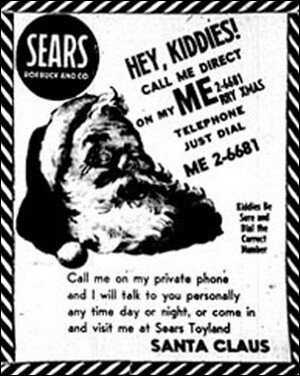I am a member of an online group of quizzers. I came across question the Santa Tracker which is used for following his progress through U.S. military radar. What also caught my attention was an interesting story behind it.
Col. Harry Shoup's of the Continental Air Defense Command, now known as NORAD, had two phones on his desk, including a red one which was a hotline. Only a four-star general at the Pentagon knew the number (ME6681).
It was the time of the Cold War, and the straight-laced and disciplined Colonel would have been the first to know if there was an attack on the United States. The hotline was use in such emergencies.
The airmen had a big glass board with the maps of the United States and Canada on it, and when airplanes would come in they would track them.
One day in the second half of December 1955, the red phone rang one day. An anxious Shoup answered it.
At the other end was a small voice that just asked, 'Is this Santa Claus?'
The stern soldier was annoyed and upset by the call. He thought it was a joke and yelled back profanities into the mouthpiece — but then, he heard the little voice crying.
It was then that he realized that it wasn't a joke, after all. So he talked to him, ho-ho-ho'd and asked if he had been a good boy and, 'May I talk to your mother?'
Things cleared up after talking to the mother for a while. She asked, 'You haven't seen the paper yet? There's a phone number to call Santa. It is ME6681. It's in the Sears Toyland ad.'
The Santa Tracker tradition started with this Sears ad, which instructed children to call Santa on what turned out to be a secret military hotline. Kids today can call 1-877 HI-NORAD (1-877-446-6723) to talk to NORAD staff about Santa's exact location.
Courtesy of NORAD
The Colonel looked it up. There it was, his red phone number.
The Colonel looked it up. There it was, his red phone number.
It got to be a big joke at the command center. Before they could say 'Sorry, wrong number', they had children calling one after another.
So the Colonel put a couple of airmen on the phones to act like Santa Claus. The airmen were amused that the old man had really flipped his lid this time and they were answering Santa calls at the Continental Air Defense Command.
It did not end there. On Christmas Eve of 1955, when the Colonel walked into his office, there was a drawing of a sleigh with eight reindeer coming over the North Pole.
The Colonel winced. 'What is that?'
'Colonel, we're sorry. We were just making a joke. Do you want us to take that down?' The airmen asked.
The Colonel looked at it for a while, and next thing you know, he called the radio station and had said, 'This is the commander at the Combat Alert Center, and we have an unidentified flying object. Why, it looks like a sleigh.'
Well, the radio stations would call him every hour and ask, 'Where's Santa now?'
And later in life he got letters from all over the world, people saying, 'Thank you, Colonel,' for having this sense of humor. And in his 90s, he would carry those letters around with him in a briefcase that had a lock on it like it was top-secret information. He was an important guy, but this is the thing he's proudest of and known for.
To think that all this started in 1955, with a misprint in a Colorado Springs newspaper!


